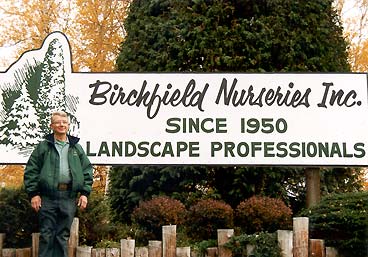About Us

A brief history of
Birchfield Nurseries
In 1950 Ralph McGuire moved up from Illinois and purchased 40 acres west of Rhinelander. His love for plants and knowledge of propagation was the beginning of Birchfield Nurseries, Inc. He strived to have the best selection of hardy; Northern grown plants and made a point of knowing customers personally so he could better help them with their landscape needs. Not only did he grow the plants, but he also went out and installed them. As time went on, additional nursery land was purchased south of Rhinelander on Hwy. G.
70 years later, Birchfield Nurseries, Inc. is growing 30,000 shrubs and trees and employing 18 people. We are dedicated to creating satisfied customers through the delivery of quality products and services. Over the years, we have achieved a tremendous reputation for offering the finest Nursery Stock and Landscape Service in all of Northern Wisconsin. To guarantee a continuation of this reputation, we always exercise the best workmanship to insure the finest end product possible.
We would like to thank all of our customers for their business over the last 70 years and hope that we can continue helping you with all of your outdoor beautification needs.

Just Starting? Here are some
Helpful Tips & Advice
- Dig a hole 12″ larger and at the same depth as the root ball.
- Loosen soil in the bottom of the hole to a depth of approximately 6″, then firm the bottom soil before setting plant.
- Set tree in the hole about 1″ deeper than it stood in the nursery.
- Cut twine or wires, roll back burlap, remove all containers.
- Fill hole half way with good soil, fill balance of hole with water. when water settles, finish filling hole with good soil to within 2″ of the surface, and fill with wood mulch or other similar material.
- Water daily for 2 weeks (on container grown plants).
- Water 3 times per week for next 4 weeks (bareroot or newly potted plants).
- Water 2 times per week for next 4 weeks.
- Water 1 time per week thereafter or when dry.
- Plants under 2 ft = 2 1/2 gallons of water each time.
- Plants 2 ft – 4 ft = 5 gallons of water each time.
- Plants 4 ft – 6 ft = 10 gallons of water each time.
- Plants 6 ft and up = 15 – 30 gallons of water each time.
Special Notes
- Depending on what Mother Nature gives us, you may have to adjust your watering. Remember, unless you have a minimum of 2″ of rainfall, you will need to stick to your watering schedule.
- Lawn sprinklers should not be used to water plants as they cannot get enough water where it is needed. Remember, leaves and needles divert water to the outside of the root ball area.
- After seeding, water frequently but lightly, 2-3 times per day (10-20 minutes each time) depending on how hot and dry the weather is.
- After 10 days to 2 weeks, water 1-2 times per day (30-45 minutes each time).
- After 3-4 weeks, reduce the frequency of watering, but INCREASE the length of time the sprinkler is on.
- After 2-3 months you should be watering 1-2 times per week, applying 1 INCH of water each week. This encourges the roots to go deeper.
Special Notes
- After 3-5 weeks apply 25-2-4 slow release fertilizer. This is an extremely important step to ensure that your lawn gets off to a healthy start. The higher nitrogen is necessary to build roots, which results in a thicker lawn with less weeds.
- Approximately September 1st. apply 12-12-20 slow release fertilizer to winterize the top.
- Approximately November 1st. apply 25-2-4 slow release fertilizer. The higher nitrogen is used to store carbohydrates in the roots so the grass has immediate energy in the spring for maximum root growth. This leads to a greener, thicker, and healthier lawn all summer long.
Examine your plants at regular intervals to determine whether or not an insect or disease problem is present. Treatment is most effective when begun early. At the first sign of insect or disease problems, contact us. With proper instruction, you can control many of these problems yourself.
Deer, rabbits, dogs, mice, etc, are doing severe damage to plant material. You must provide protection. For more information please contact the professionals at Birchfield Nurseries.
Perennials
| Ornamental Grass | Achillea | Yarrow |
| Agastache (Golden Jubilee Licorice Plant) | Agastache (Anise Hyssop) | Ajuga |
| Artemisia (Silver Mound) | Artemisia (Silver Brocade) | Asclepias (Butter Fly Flower) |
| Astilbe | Gaillardia | Iris |
| Lamiastrum | Lavendula (Munstead Strain) | Liatris |
| Lupine | Mentha (Peppermint) | Monarda (Bee Balm) |
| Nepeta (Walker Low Catmint) | Pachysandra | Perovskia (Russian Sage) |
| Pholx | Polygonum (Magic Carpet) | Salvia |
| Sedum | Snow on Mountain | Solidago (Fireworks Goldenrod) |
| Stachys (Lambs Ear) | Spiderwort | Sun Shine Speedwell |
| Thyme | Veronica |
Shrubs
| Barberry | Cotoneaster | Forsythia |
| Potentilla | Japanese Tree Lilac | Roses |
| Blueberries | Raspberries | PJM Rhododendron |
| Alpine Currant | Spirea | Stephenandra |
| Emerald Triumph Vibrunum | Mohican Viburnum | Rhubarb |
Evergreens
| Balsam Fir | Larch | Russian Cypress |
| Birdsnest Spruce | Dwarf Alberta Spruce | Junipers |
| Norway and White Pine | Colorado Spruce | Black Hills Spruce |

